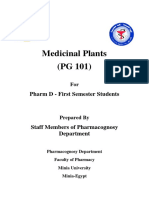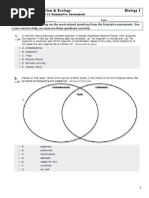Introduction To Botany
Introduction To Botany
Uploaded by
okutejoseph520Copyright:
Available Formats
Introduction To Botany
Introduction To Botany
Uploaded by
okutejoseph520Original Title
Copyright
Available Formats
Share this document
Did you find this document useful?
Is this content inappropriate?
Copyright:
Available Formats
Introduction To Botany
Introduction To Botany
Uploaded by
okutejoseph520Copyright:
Available Formats
INTRODUCTION TO BOTANY
Botany is the scientific study of plant life and development. It covers a wide range of
scientific disciplines that study plants, algae, and fungi including: structure, growth,
reproduction, metabolism, development, diseases, chemical properties, and
evolutionary relationships between the different groups.
Study of plants is one of the oldest sciences which began with efforts to identify edible,
medicinal and poisonous plants.
Scope and importance of botany
Plant life can be studied from different perspectives, from the molecular, genetic and
biochemical level through organelles, cells, tissues, organs, individuals, plant
populations, and communities of plants.
A good understanding of plants is crucial to the future of human societies as it allows us
to:
• Produce food to feed an expanding population
• Understand fundamental life processes
• Produce medicine and materials to treat diseases and other ailments
• Understand how environmental changes can affect plant products
Human nutrition
Nearly all the food we eat comes (directly and indirectly) from plants. Plants are the
fundamental base of nearly all food chains. Botanists also study how plants produce
food we can eat and how to increase yields and therefore their work is important in
mankind's ability to feed the world and provide food security for future generations.
Fundamental life processes
Plants are convenient organisms in which fundamental life processes (like cell division
and protein synthesis) can be studied, without the ethical dilemmas of studying animals
or humans. The genetic laws of inheritance were discovered in this way by Gregor
Mendel, who was studying the way pea shape is inherited.
P. AKOTH SBT 2110 BOTANY 2024
Subdisciplines of Botany
• Agronomy—Application of plant science to crop production
• Bryology—Mosses, liverworts, and hornworts
• Economic botany—Study of plants of economic use or value
• Ethnobotany—Relationship between humans and plants
• Forestry—Forest management and related studies
• Horticulture—Cultivated plants
• Lichenology—The study of lichens
• Paleobotany—Fossil plants
• Palynology—Pollen and spores
• Phycology—Algae
• Phytochemistry—Plant secondary chemistry and chemical processes
• Phytopathology—Plant diseases
• Plant anatomy—Cell and tissue structure
• Plant ecology—Role of plants in the environment
• Plant genetics—Genetic inheritance in plants
• Plant morphology—Structure and life cycles
• Plant physiology—Life functions of plants
• Plant systematics—Classification and naming of plants
P. AKOTH SBT 2110 BOTANY 2024
PRINCIPLES AND CLASSIFICATION OF PLANT KINGDOM
OVERVIEW OF GENERAL CLASSIFICATION
• According to Carolous Linnaeus (1700s) all matter fitted into 3 kingdoms –
animals, plants or minerals.
• With the help of the microscope (1600s) it was discovered that there existed a
third group of organisms that could not fit under these 2 kingdoms, and was
named protoctista.
• Many more discoveries have been discovered since then.
• The most accepted classification is that of Whittaker, 1969 where he classified
organisms into 5 kingdoms.
• Monera – single cells without a nuclear membrane
• Protoctista – eukaryotic and have 3 modes of feeding; absorption,
ingestion and synthesis
• Fungi – eukaryotic, multicellular and saprophytic
• Animals – eukaryotic and heterotrophic
• Plants – photoautotrophic, cellulose cell wall and stationary.
The demerits of Whittaker’s 5-Kingdom classification.
• Some organisms could not be delineated based on nutrition/mixotrophic e.g.
Euglena.
• In algae level of cell organization could not be used/unicellular and multicellular
algae
• Although slime moulds produce sporangia they are classified as protistans
• Viruses have not been included in this system of classification.
• Archaebacteria differ from other bacteria in structure, composition and
physiology.
• Mycoplasmas are different from bacteria but are still monerans
P. AKOTH SBT 2110 BOTANY 2024
• Plants are classified as follows:
• Non-vascular plants – Bryophytes
• Vascular – non-seed bearing – pteridophytes
• Vascular seed-bearing, non-flowering – gymnosperms
• Vascular seed-bearing, flowering – angiosperms
The scope of this course: Higher plants refer to the seed-bearing tracheophytes
(spermatophytes). There are over 250,000 species of angiosperms and over 750
species of gymnosperms.
INTRODUCTION TO TAXONOMY OF HIGHER PLANTS
• The human mind has an inherent ability to perceive the similarities and
discontinuities of patterns in nature. This ability has been applied naturally to
classify plants over many years. Classification has been driven by curiosity or
classification for the sake of it, or plant uses such agricultural, medicinal,
religious and cultural uses.
• There are over 400,000 species of plants on earth; to be able to refer to these
plants with certainty there is need to classify and name them.
The objectives of plant taxonomy include:
1. To identify and give scientific names to all the plants both existent or fossils.
2. To find out the similarities and differences between the plants identified and
named.
3. To arrange the plants in a regular sequence.
4. To provide an inventory of plant taxa by means of flora.
5. To devise a natural system of classification and to assign proper status to group
of plants
6. To find out the evolutionary history of a species and to find its relation with others.
7. To construct rules and regulations governing the method to name a species,
genus or family.
P. AKOTH SBT 2110 BOTANY 2024
COMPONENTS OF TAXONOMY
Taxonomy or systematic botany deals with classification, nomenclature and
identification of plants.
1. Classification – ordering of plants according to their similarities
2. Nomenclature – this is giving of plant names. It is governed by the ICN, formerly
ICBN which stipulates the criterion used in assigning names
3. Identification – placing a plant in an already classified and named taxon.
CLASSIFICATION
1. History of plant taxonomy and development of taxonomic units.
Taxonomy could be the oldest science and has evolved through different phases which
can be summarised as:
a. Artificial
b. Natural
c. Phylogenetic systems
Artificial means
• Plants are classified conveniently based on several key characters, often easily
observable. Examples include picture guides to plants; roadside floras based on
flower colours, plant growth habits etc.
• It doesn’t use evolutionary relationships hence related plants may be separated
while unrelated groups are put together. This makes the classification limiting and
mostly inaccurate.
• This system has the advantage of easy identification e.g. gardeners looking for
flowers, carpenters looking for good timber, tourists etc.
Natural classification
• Plants are grouped together based on the sum total of all their characters.
• It reflects the situation as it is believed to exist in nature
• It reflects the evolutionary descent
P. AKOTH SBT 2110 BOTANY 2024
Phylogenetic
• Classifies plants according to their evolutionary sequence and genetic relationships
• Enables identification of ancestors and derivatives of any taxon.
• Phylogenetic systems are rarely pure but use some natural and artificial
classification. This is because there isn’t much knowledge of evolutionary relations.
E.g. artificial – all wood fossil may be grouped together.
Phylogenetic Classification has the following limitations:
1. it is rarely possible to construct with certainty the past evolutionary pathways
due to poorness of fossil record
2. it is hardly possible to devise a satisfactory method of designating a branching
pattern by means of a single sequence which is needed in a flora.
• Taxonomy provides a classification based on evolutionary relationships. But the
goal of attaining a truly natural system of classification remains unfulfilled. So ,it
is essential to have a comprehensive knowledge of the taxa from various aspects
and various branches of botany.
• Therefore ,various aspects of botany like anatomy, embryology, phyto-chemistry
and the newly developed techniques of molecular biology and new aspects of
taxonomy i.e. numerical taxonomy are include under taxonomy and thus,
taxonomy has now become a synthetic discipline.
2. OVERVIEW OF THE CONCEPT OF TAXA (DEFINITION OF MEANING OF THE
TAXON/LABEL)
Taxonomy deals with plant description. Classification is an orderly system with the
following major categories:
Kingdom – Division – Class – Order – Family
Minor categories: genus – species – subspecies –variety – Forma- cultivar.
These categories have been expanded to include “sub”- and “super” –categories.
Taxons are labels for ordered groups. They are assigned ranks.
P. AKOTH SBT 2110 BOTANY 2024
According to the ICN, plant taxa have standard endings as follows:
Division – phyta
Subdivision – phytina
Class – Opsida
Subclass – idea
Superorder - anae
Order – ales
Suborder – ineae
Superfamily - acea
Family – aceae
Subfamily – oideae
Tribe - eae
P. AKOTH SBT 2110 BOTANY 2024
Kingdom: there 5 kingdoms according to Whittaker Plantae, Animalia, Fungi, Protista and
Monera. They are the major categories into which scientists classify organisms. Plant
kingdom defining characteristics are the cellulose cell wall and ability to photosynthesise.
Division: consists of many classes
Class: a group of orders that have many similar characteristics
Order: this is composed of several families closely related. Members have at least one
phyletically important character. (phyletic – overall differences/similarities in a plant group).
Family: it is the highest /largest taxonomic category encountered in ordinary taxonomic
work. Consists of many genera. Members evidently belong to one ancestor.
Genus: it is the most basic grouping of plants. The taxon is used in binomial nomenclature.
Species: this is a series of recognizably similar individuals that are distinct different from
other such series. They are interfertile with one another and isolated reproductively from
other series. (this definition is limiting if groups are not reproducing, fossils).
Subspecies: this is a baby species/incipient that has not progressed much evolutionary. It
is however sufficiently distinct morphologically and genetically.
Variety: this is a morphological variant of species without regard to distribution.
Forma: sporadic variant. Shows a single character difference due to gene change.
Cultivar: this is a sub-population of a species that has been bred and shows stable
characteristics that if propagated appropriately retains those characteristics.
Hybrid: plant resulting from cross of 2 plants of different genetic make up.
NOMENCLATURE
• It’s the naming of plants using a scientific system
Common names
The names given to plants on the basis of language of that locality in which the plants are
growing are known as Common Names or Vernacular Names.
Why the common names are disadvantageous?
1. They are not universal, different in every language and locality
P. AKOTH SBT 2110 BOTANY 2024
2. Common names are not consistent. A taxon may have more than one common name or
one common name may refer to more than one taxon (e.g., pigweed)
3. Many of the organisms have no common name in any language.
4. Common names tell nothing about rank.
Scientific names
To overcome the problem raised by common names , botanists have given scientific names
to
all the known plants, for International communication. The language selected for this
naming was LATIN because it is:
o Dead language
o Specific and exact in meaning
o Most old literature was in Latin
o Common scholarly language of early days
• Nomenclature is governed by the ICN (international classification of biological
nomenclature). The members of the congress sit every 6 years to review principles
and rules, take in new developments
• The ICN designs principles, divisions and common rules that should govern plant
naming. There are 6 principles.
PRINCIPLES OF THE ICBN (ICN)
Principle I: Botanical nomenclature is independent of zoological and bacteriological
nomenclature. The Code applies equally to names of taxonomic groups treated as plants
whether or not these groups were originally so treated
Principle II: The application of names of taxonomic groups is determined by means of
nomenclatural types i.e, llustration to which the name of a taxon (species, genus,
subspecies, variety, etc.) is permanently assigned.
Principle III: The nomenclature of a taxonomic group is based upon priority of publication.
Principle IV: Each taxonomic group with a particular circumscription, position, and rank can
bear only one correct name, the earliest that is in accordance with the Rules, except in
specified cases.
P. AKOTH SBT 2110 BOTANY 2024
Principle V: Scientific names of taxonomic groups are treated as Latin regardless of their
derivation.
Principle VI: The Rules of nomenclature are retroactive (taking place effect from a date in the
past) unless expressly limited.
A lot is still happening in Nomenclature. The first consolidated checklist of the world's
plants was completed in 2010. This list provides a catalogue of plant names organised
to show which names are accepted and which are considered synonyms. The Plant List
currently holds over 1 million plant species names, of which around 350,000 are
accepted names. Over 240,000 names remain to be resolved into 'accepted name' or
'synonym'.
Additionally the number of plant species are under threat is also unclear, but it is
estimated that around 1 in 5 (20%) plant species are threatened with extinction.
P. AKOTH SBT 2110 BOTANY 2024
You might also like
- The Survey of Plant KingdomDocument28 pagesThe Survey of Plant Kingdomkerry100% (2)
- Plant and Animal TaxonomyDocument17 pagesPlant and Animal TaxonomyVictoriaNo ratings yet
- Purpose of Taxonomy in BiologyDocument7 pagesPurpose of Taxonomy in BiologytboylingweNo ratings yet
- Diversity in The Living WorldDocument28 pagesDiversity in The Living WorldPalv BgNo ratings yet
- Diversity in Living Organ.8663501.powerpointDocument15 pagesDiversity in Living Organ.8663501.powerpointMohammed Arshad AliNo ratings yet
- BOTA 101-General Botany - Notes-Upto FungiDocument168 pagesBOTA 101-General Botany - Notes-Upto Fungidylysknigthley2023No ratings yet
- SYSTEMATICTAXONOMYmainDocument26 pagesSYSTEMATICTAXONOMYmainRachel BiagNo ratings yet
- Debdutta Das (Biology)Document10 pagesDebdutta Das (Biology)dev823510No ratings yet
- Biodiversity Simplified NotesDocument14 pagesBiodiversity Simplified Notesgamer2girlNo ratings yet
- The Roster of Microbes and Multicellular ParasitesDocument55 pagesThe Roster of Microbes and Multicellular ParasitesHendrik_NurfitriantoNo ratings yet
- Unit-1 Taxonomic Concepts and Their DevelopmentDocument13 pagesUnit-1 Taxonomic Concepts and Their DevelopmentAmit RajNo ratings yet
- 1-4 Expectations of Biologists From Taxonomists TodayDocument4 pages1-4 Expectations of Biologists From Taxonomists TodaySushil Kumar SinghNo ratings yet
- 1 - PHA611 LEC - Introduction To Plant ScienceDocument67 pages1 - PHA611 LEC - Introduction To Plant SciencehilaryblancelinsanganNo ratings yet
- Principles of TaxonomyDocument17 pagesPrinciples of TaxonomyGiven GraceNo ratings yet
- Literature Review 3. Methodology 4. Results 5. Discussion 6. Conclusion 7. References 8. AppendicesDocument44 pagesLiterature Review 3. Methodology 4. Results 5. Discussion 6. Conclusion 7. References 8. Appendicestaxegid865No ratings yet
- Assignment 1Document2 pagesAssignment 1skz4419No ratings yet
- Introduction To Plant SystematicsDocument10 pagesIntroduction To Plant SystematicsIzba SanaNo ratings yet
- LMMU MICRO 2010 - Microbial Systematics and TaxonomyDocument26 pagesLMMU MICRO 2010 - Microbial Systematics and Taxonomymctime35No ratings yet
- Botani PendahuluanDocument26 pagesBotani PendahuluanErfianty AnizanNo ratings yet
- 63079875bc0df10013b119e3-1693048697-INTRODUCTION TO BOTANY - RBADocument6 pages63079875bc0df10013b119e3-1693048697-INTRODUCTION TO BOTANY - RBAPrincess Jerme Esparcia ColipanoNo ratings yet
- PHA611 LEC 1st ShiftingDocument225 pagesPHA611 LEC 1st ShiftingGAILE MEIZTY MOSADANo ratings yet
- Plant Taxonomy NotesDocument49 pagesPlant Taxonomy NotesPegNo ratings yet
- CHAPTER 1 Plant Classification PrinciplesDocument32 pagesCHAPTER 1 Plant Classification PrinciplesDarwiis Khama100% (3)
- Unit 1 for BZ and BM (1)Document15 pagesUnit 1 for BZ and BM (1)hiteshvetrivel.01No ratings yet
- 1-PBT TerminologiesDocument3 pages1-PBT TerminologiesvictoriareyzzakayNo ratings yet
- Topic 3 - Origin and Evolution of BotanyDocument4 pagesTopic 3 - Origin and Evolution of BotanyvictoriareyzzakayNo ratings yet
- Botany 2021Document86 pagesBotany 2021yuolakuacyuolyarNo ratings yet
- Lecture 14Document19 pagesLecture 14DIMPHO ZILWANo ratings yet
- General Science (Biological Sciences) : Dr. Sanawar IqbalDocument19 pagesGeneral Science (Biological Sciences) : Dr. Sanawar IqbalAbdullah khalidNo ratings yet
- Let's Revise! Living World and Biological Classification.Document4 pagesLet's Revise! Living World and Biological Classification.《Nakul Chourasiya》No ratings yet
- Bota 100 Nov 2022-1Document45 pagesBota 100 Nov 2022-1tituskipngetich55No ratings yet
- Presentation 1Document31 pagesPresentation 1Soo Ming Huey 明慧No ratings yet
- Taxonomy Botany Lecture Notes 4.Document130 pagesTaxonomy Botany Lecture Notes 4.nicholausmasaka148No ratings yet
- +1 Biology Chapter 1 PDFDocument22 pages+1 Biology Chapter 1 PDFArjun v sNo ratings yet
- BIO 101 SLIDE NOTE 2Document51 pagesBIO 101 SLIDE NOTE 2treasureonyemaechi66No ratings yet
- Life VarityDocument23 pagesLife VaritySubhan ullah TutorialNo ratings yet
- TAXONOMY.pptxDocument36 pagesTAXONOMY.pptxdonielleanderson07No ratings yet
- PCG 502 - 2023 - DR Attah F AlfredDocument38 pagesPCG 502 - 2023 - DR Attah F AlfredAbdulafeez PelumiNo ratings yet
- Title:: Identification of Angiospermic Plants To Genus and Species Level Within A Known Family AbstractDocument43 pagesTitle:: Identification of Angiospermic Plants To Genus and Species Level Within A Known Family Abstracttaxegid865No ratings yet
- Protista Dan Fungi Kel 3Document21 pagesProtista Dan Fungi Kel 3tiara8heldinaNo ratings yet
- Introduction To BotanyDocument44 pagesIntroduction To BotanyEDREIAN BUENAVISTANo ratings yet
- Manual TaxonomiaDocument69 pagesManual Taxonomiacleicymartins1636No ratings yet
- Microbial Taxonomy Mcba p1 TDocument119 pagesMicrobial Taxonomy Mcba p1 TShikha GuptaNo ratings yet
- CFTRI EXAM E Book Preparation-1Document488 pagesCFTRI EXAM E Book Preparation-1Sidharth ChaturvediNo ratings yet
- BotanyDocument264 pagesBotanyGokul AdarshNo ratings yet
- m5 - Classification of AnimalsDocument30 pagesm5 - Classification of AnimalsDaisy RamaNo ratings yet
- Document from Pelumusðð½Document26 pagesDocument from Pelumusðð½jennifernicolee200No ratings yet
- CpSci 101 - Module 5 - Lesson 1 and 2Document7 pagesCpSci 101 - Module 5 - Lesson 1 and 2Regan Roldan RolaNo ratings yet
- Beta Monic Ai-MonicaiDocument7 pagesBeta Monic Ai-MonicaiJAYAKUMARNo ratings yet
- Unit 5 Data Sources in Taxonomy - 231113 - 112144Document63 pagesUnit 5 Data Sources in Taxonomy - 231113 - 112144dd6893452No ratings yet
- "Biodiversity" Is A Concise Form of "Biological Diversity" and Was Biodiversity Is The Occurrence of Diverse or Varied Forms of Living Beings WhichDocument11 pages"Biodiversity" Is A Concise Form of "Biological Diversity" and Was Biodiversity Is The Occurrence of Diverse or Varied Forms of Living Beings Whichbrm1shubhaNo ratings yet
- Classification of Botany and Use of Plants Author Instytut Zootechniki PIBDocument173 pagesClassification of Botany and Use of Plants Author Instytut Zootechniki PIBZai AtienzaNo ratings yet
- Std12 Botany EMDocument267 pagesStd12 Botany EMRUBANNo ratings yet
- (L+1) +chapter+02+ Biological+Classification++NEET+Questions+Menti+++ +DPP+Document48 pages(L+1) +chapter+02+ Biological+Classification++NEET+Questions+Menti+++ +DPP+AMISHA RATHISHNo ratings yet
- Classification: SystematicsDocument20 pagesClassification: Systematicsmurari_sahuNo ratings yet
- 2 Classification and NomenclatureDocument44 pages2 Classification and NomenclatureYanah Maristela PollescasNo ratings yet
- College B Otan Y: (NimohDocument1,209 pagesCollege B Otan Y: (NimohFATIMA HASANNo ratings yet
- Taxonomy and Kingdoms Webquest 2019Document4 pagesTaxonomy and Kingdoms Webquest 2019Aakash ReddyNo ratings yet
- Quadrat SamplingDocument4 pagesQuadrat SamplingKhairunnisa EsamNo ratings yet
- Practical 1 Isolation of AlgaeDocument67 pagesPractical 1 Isolation of Algaeepick7No ratings yet
- Ch. 1 - Evolution, The Themes of Biology, and Scientific InquiryDocument16 pagesCh. 1 - Evolution, The Themes of Biology, and Scientific Inquiryjanuvenuraka0No ratings yet
- MHT Cet Triumph Biology Mcqs Based On STD Xi Xii Syllabus MH Board 12741 SolDocument117 pagesMHT Cet Triumph Biology Mcqs Based On STD Xi Xii Syllabus MH Board 12741 SolPrathamesh Hase100% (1)
- Chapter 1 Sample Test Living ThingsDocument13 pagesChapter 1 Sample Test Living ThingsyasinalifNo ratings yet
- 11 Revised Biology 21 PDFDocument10 pages11 Revised Biology 21 PDFShubhendu ChattopadhyayNo ratings yet
- Basics of MicrobiologyDocument113 pagesBasics of Microbiologycontact.arindamdas7No ratings yet
- Trueman's Elementary Biology PDF AndroboseDocument274 pagesTrueman's Elementary Biology PDF AndrobosePulakeswar Mohanta50% (2)
- Chapter 10 ChemotaxonomyDocument17 pagesChapter 10 Chemotaxonomynsjunnarkar75% (4)
- BioHack Class XI BookDocument242 pagesBioHack Class XI Booktkaur9278No ratings yet
- Pharmacognosy BookDocument100 pagesPharmacognosy BookYoussef ElhamamyNo ratings yet
- Bgy 101 Lecture NotesDocument48 pagesBgy 101 Lecture Notesidrisaminuabdullahi26No ratings yet
- The Five Kingdoms of Life: Kingdom Characteristics & Important Information ExamplesDocument2 pagesThe Five Kingdoms of Life: Kingdom Characteristics & Important Information ExamplesDay1410No ratings yet
- Etea Mcqs Class 5Th Science Chapter No.1St/2Nd Total 50+ Mcqs. 1: Classification of Animals and Plants Is Called - ? A: EcologyDocument5 pagesEtea Mcqs Class 5Th Science Chapter No.1St/2Nd Total 50+ Mcqs. 1: Classification of Animals and Plants Is Called - ? A: EcologyUmair HabibNo ratings yet
- Biology - BiodiversityDocument0 pagesBiology - Biodiversitywww.bhawesh.com.npNo ratings yet
- Biological Classification: Demerits of The ClassificationDocument44 pagesBiological Classification: Demerits of The ClassificationSaket DubeyNo ratings yet
- Classificationof00blac BWDocument104 pagesClassificationof00blac BWabdur2011100% (1)
- Chapter 1: Introduction - The Science of Biology: Biol 1020 - Chapter 1 Lecture NotesDocument5 pagesChapter 1: Introduction - The Science of Biology: Biol 1020 - Chapter 1 Lecture NotesSeth MacsNo ratings yet
- BIO 111: Chapter 1 Lecture PresentationDocument108 pagesBIO 111: Chapter 1 Lecture PresentationDuscDragon100% (1)
- Grade 9 Characteristics of LifeDocument36 pagesGrade 9 Characteristics of LifeKevin CheowNo ratings yet
- OCB Student Handbook v3.1Document277 pagesOCB Student Handbook v3.1Aztec TripleNo ratings yet
- Biology BookletDocument345 pagesBiology BookletKaushik OjhaNo ratings yet
- Chapter-Wise DPP Sheets For Biology NEET - NodrmDocument42 pagesChapter-Wise DPP Sheets For Biology NEET - NodrmBibhu Prasad Sahoo38% (8)
- Biology F2 M-1Document56 pagesBiology F2 M-1Stanley AkuamoahNo ratings yet
- Ds111-Unit 11 Summative AssessmentDocument6 pagesDs111-Unit 11 Summative Assessmentapi-110789702No ratings yet
- Biological ClassificationDocument9 pagesBiological ClassificationAdarsh Chobey0% (1)
- Life Sciences Gr.11 Lesson 1 Basic Structure of VirusesDocument16 pagesLife Sciences Gr.11 Lesson 1 Basic Structure of Virusestmalatji106No ratings yet

























































































